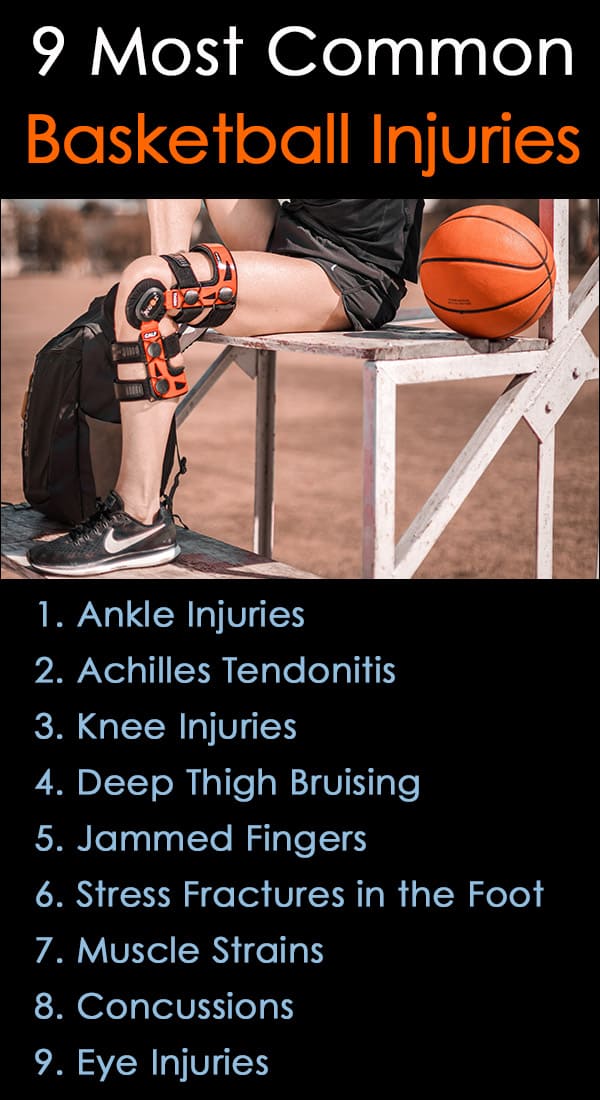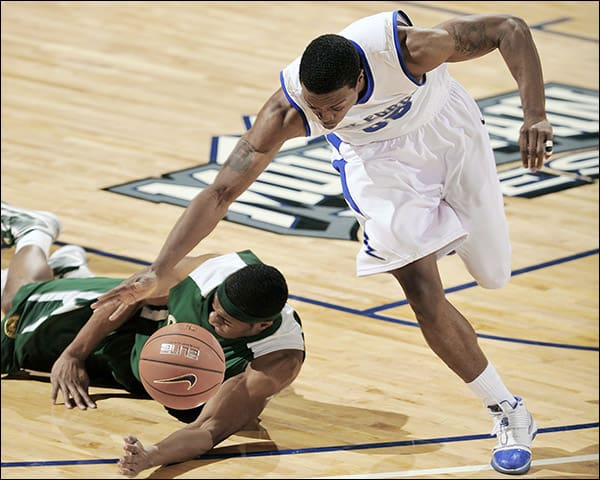There are many common basketball injuries that can sideline a player temporarily, or even worse, for the entire season. Some have even ended careers.
From professional athletes, all the way down to players in a pick-up game and young hopefuls that might suffer college basketball injuries on their way to the pros, the game of basketball can be a rough and tough endeavor that comes with inherent risks to the body.
Playing hoops involves short, intermittent bursts of intense activity combined with physical contact and quick stops and starts, all of which can lead to serious injury.
However, it’s not just during the game that players are prone to injury. The constant beating that joints take from running, jumping, passing, blocking, and twisting can also lead to overuse stress and injury.
Understanding the cause of the most common basketball injuries is key in not just heading off injuries, but also deploying the most effective treatment methods at the first sign of any type of injury.
What are the Most Common Basketball Injuries?
When examining the most common basketball injuries, some are typical for players of all ages and skill levels, while others are usually only experienced by those at the higher levels.
Preparing and training can help reduce the chances of an injury from happening. Nonetheless, it’s important to recognize that many injuries in basketball usually occur when least expected. Knowing about possible injuries before they occur can help everyone prepare ahead of time.
9 of the Most Common Basketball Injuries
1. Ankle Injuries in Basketball
Most athletes are familiar with ankle sprains, which are caused when the ankle joint is rolled, twisted, or turned in away that overly stretches or tears soft tissue in the ankle joint.
Pain, inflammation, and even bruising often follow. This can limit a person’s range of motion, render the foot unable to support weight without pain, and keep a person out of the game for many weeks if the injury is serious.
If left untreated, an ankle sprain can become a more serious condition like ankle tendonitis, known medically as Peroneal Tendonitis.

2. Achilles Tendonitis
The Achilles is the band of tightly woven tissue that connects the calf muscles to the heel bone. Because of the movements involved in basketball, the Achilles is continuously stressed and can develop micro-tears that lead to chronic inflammation and pain.
At first, pain in the Achilles may dissipate as an athlete warms up, but left undiagnosed and untreated, it will worsen, causing pain, limiting movement and making it impossible to function at high levels.
There are several types of tendonitis in the achilles, with Insertional Achilles Tendonitis being the most painful, and affecting older players more frequently than younger ones.
3. Basketball Knee Injuries
From jumper’s knee, referred to as Patellar Tendonitis, to ACL (anterior cruciate ligament) tears, the knee joint is extremely vulnerable for basketball players.
A basketball knee injury can lead to pain, inflammation, and weakness in the joint, all of which can cause even greater damage if ignored.
Following proper strength training, technique on the court, and warm-up and cool down stretching is key in preventing basketball knee injuries, which have been known to knock down even the most fit of professionals for a season or more.
4. Deep Thigh Bruising
Physical contact among a crowded court of players is inevitable in basketball, amid the chaos of sprints that end with jumps.
Deep bruising generally occurs when a players’ thigh makes contact with the knee or elbow of another player under great force. Deep thigh bruising can cause pain, inflammation, and weakness that can take several weeks to heal.
5. Jammed Fingers
From dribbling and passing, to blocking and even dunking, the fingers are almost always at risk during basketball.
When the top of the finger comes into contact with the ball, the rim, or another player, it can be jammed into the joint.
This can be a painful injury, leading to swelling and making full use of the hands difficult. Proper technique and awareness is key in preventing jammed fingers.
A jammed finger is not considered one of the worst injuries in basketball, but it is certainly one of the most common.
6. Stress Fractures in the Foot
Stress fractures occur when the muscles in the foot are too tired or overused to absorb the impact and stress of running, jumping, stopping, and sprinting, leaving the bones vulnerable to tiny cracks or breaks known as fractures.
Stress fractures are often considered overuse injuries, but they can also be caused by poor-fitting or improper footwear, the surface being played on, and playing too quickly after injury.
7. Muscle Strains
Not entirely dissimilar from sprains, muscle strains occur when athletes stretch a particular muscle beyond its normal capacity or the load placed on the muscle is too great.
In basketball, shoulder and leg strains are common because of the motion involved in shooting, running, blocking, and passing. Athletes may feel or hear a popping or snapping sound, as well as experience pain and inflammation in the strained muscle.

8. Concussions
While concussions are not usually at the top of list when people think of basketball injuries, they are more common than most realize.
A head injury can occur with a forceful contact to the head, whether it’s caused by a player’s head hitting the floor, or from coming into contact with another player.
The impact can leave athletes feeling nauseous, dizzy, having blurred vision, and often headaches. Even a mild concussion can be a serious injury that should be examined or treated by a physician.
9. Eye Injuries
Protective glasses, goggles, or a face-shield have become a more common sight in professional and collegiate basketball for the simple reason that they help prevent eye injuries.
Getting a finger or thumb in the eye, or even a direct hit from the ball can cause a scratched cornea, corneal flap dislocation, or bruising that leads to blood in the front of the eye that blurs vision.
Treatment Methods for Common Basketball Injuries
Treatment approaches for a basketball injury will vary depending on the type and severity of the issue.
Having a plan for immediately treating all injuries will offer the best chance of reducing recovery time.
Typical Treatment Methods for Common Basketball Injuries Include:
1. The RICE Method
RICE stands for Rest, Ice, Compress and Elevate. This conservative approach for treating basketball injuries is effective for minor strains, bruises, and general muscle or bone issues. RICE works best when used within the first few days of an injury.
Ice is effective for reducing pain and inflammation, and compression will help support an injured joint. Rest gives the injury time to heal and reduces stress on the area. Whenever possible, elevate the injury higher than the heart.
2. Taping and Strapping
Proper taping and strapping can aid in supporting areas like the elbows and knees, and the extra tension will reduce muscle and soft-tissue stress.
Some players tape injury prone areas before playing or working out to avoid developing an injury before it happens. This can help players continue training or playing in games.

3. EPAT Therapy (Shockwave)
EPAT Therapy is a painless, noninvasive method for speeding up the healing process for many common basketball injuries. EPAT uses impulse pressure waves that are delivered deep into muscles and tissue to increase blood flow and decrease inflammation to the affected area.
This type of treatment is used by many college and professional basketball teams and trainers, and is often referred to as Shockwave Therapy because the pressure waves are also called “shock waves.”
With EPAT / Shockwave Therapy, there is no scaring or risk of infection, like with surgery, and the treatment sessions can be delivered while a player continues to train and play without suffering from performance issues or recovery downtime.
4. Nonsteroidal Anti-Inflammatory Medications
Nonsteroidal Anti-Inflammatory Medications, like ibuprofen found in Advil or Motrin, are effective at reducing pain and minimizing inflammation.
These are over-the-counter medications that are safe to use without complications and do not require a prescription.
Depending on the type of basketball injury, some trainers use cortisone injections for decreasing serious inflammation. Use of these types of injections has been dwindling over the years because they are a temporary fix that should not be used frequently.
5. Physical Therapy
For most common basketball injuries, even minor ones, physical therapy can be a practical way to strengthen the injured area and to aid in recovery.
Some physical therapists will work on form and technique to reduce the chances of developing new injuries.
Physical therapy is sometimes used in conjunction with other treatment methods like EPAT Therapy to speed up recovery and healing.
6. Surgery
Many of the common basketball injuries outlined here do not require surgery. That is fortunate for players and teams because surgery always comes with some risk and leads to longer recovery times, and the possibility of missing part, or all of the season.
Surgery is usually reserved for the worst basketball injuries, like specific types of knee or ankle injuries. If the injury is not too serious, professional players will elect to have surgery done in the off-season whenever possible.
Hopefully the treatment methods outlined here will be helpful for overcoming some of the most common injuries in basketball for a speedy recovery.